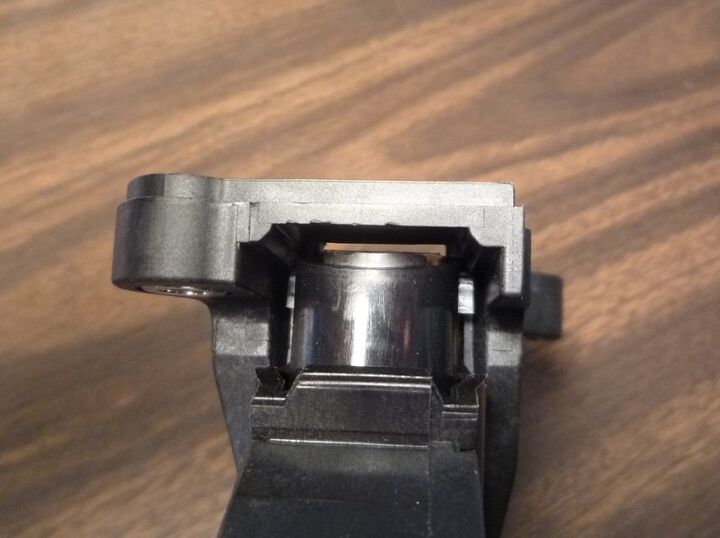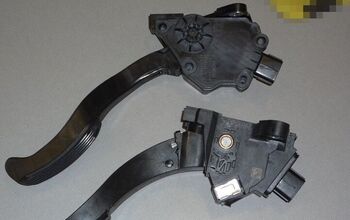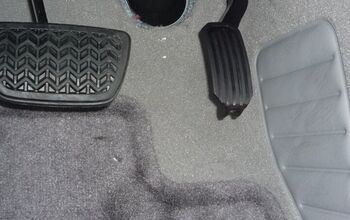Toyota Gas Pedal Fix Simulated: Friction Reduced, But By Too Much?

Update: a portal to all of TTAC’s articles on the subject of Toyota gas pedals is here:
We’ve taken it apart, explained Toyota’s intended fix, and now we’ve replicated the “fix” to see what effect it has. It works, but does it work too well?
In the photo above, the two friction teeth are shown in their operating position before the “fix”. One can easily see their pivot axle sticking out to both sides, in a lighter gray color, just where the friction unit protruded from the housing. The other end of this friction unit is the retainer for the return spring, and this is what creates the pressure on the friction teeth.
The second picture (above) shows the other end of this unit. The round end in the middle of the unit is where the coil spring is retained. The gap as shown in this picture is where the metal spacer would go. It would change the fulcrum angle, and the amount of pressure that the spring would exert on the friction teeth.
In the third picture (above) we have inserted a 1/8″ thick screwdriver shank to simulate a spacer in this area. We don’t know yet what thickness the Toyota space will have, so this is an arbitrary guess to see the effect. The amount of friction was substantially reduced by this increase in the gap, and the change in the fulcrum angle of the friction bar unit. We were not able to actually install the unit in a car to see how it would feel, but the change in feel was very noticeable to the hand.
As we’ve explained in the prior post, the balance of friction to the control spring is what creates a stable, yet safe pedal assembly. By reducing the friction, the pedal will feel “less stable”, and it might be more difficult to maintain a steady throttle opening. The perceived pressure felt by the foot will also be greater. The degree of this affect will of course depend on the thickness of the spacer Toyota specifies.
Undoubtedly, this fix will profoundly reduce the likelihood or possibility of the pedal being stuck or slow to return. But the trade off may not be immaterial. Undoubtedly, Toyota’s intended degree of friction will be compromised by this fix, to one degree or another. And drivers may find the fix unpleasant or uncomfortable, also to some degree or another. Clearly, this fix is a band aid to fix the intrinsic limitations of this design. We will be taking a closer look at the Denso pedal next to see how their design is different.
Update: The final article in this series compares the two pedals (CTS and Denso), and makes a recommendation. Link here.

More by Paul Niedermeyer
Latest Car Reviews
Read moreLatest Product Reviews
Read moreRecent Comments
- Alan Well, it will take 30 years to fix Nissan up after the Renault Alliance reduced Nissan to a paltry mess.I think Nissan will eventually improve.
- Alan This will be overpriced for what it offers.I think the "Western" auto manufacturers rip off the consumer with the Thai and Chinese made vehicles.A Chinese made Model 3 in Australia is over $70k AUD(for 1995 $45k USD) which is far more expensive than a similar Chinesium EV of equal or better quality and loaded with goodies.Chinese pickups are $20k to $30k cheaper than Thai built pickups from Ford and the Japanese brands. Who's ripping who off?
- Alan Years ago Jack Baruth held a "competition" for a piece from the B&B on the oddest pickup story (or something like that). I think 5 people were awarded the prizes.I never received mine, something about being in Australia. If TTAC is global how do you offer prizes to those overseas or are we omitted on the sly from competing?In the end I lost significant respect for Baruth.
- Alan My view is there are good vehicles from most manufacturers that are worth looking at second hand.I can tell you I don't recommend anything from the Chrysler/Jeep/Fiat/etc gene pool. Toyotas are overly expensive second hand for what they offer, but they seem to be reliable enough.I have a friend who swears by secondhand Subarus and so far he seems to not have had too many issue.As Lou stated many utes, pickups and real SUVs (4x4) seem quite good.
- 28-Cars-Later So is there some kind of undiagnosed disease where every rando thinks their POS is actually valuable?83K miles Ok.new valve cover gasket.Eh, it happens with age. spark plugsOkay, we probably had to be kewl and put in aftermarket iridium plugs, because EVO.new catalytic converterUh, yeah that's bad at 80Kish. Auto tranny failing. From the ad: the SST fails in one of the following ways:Clutch slip has turned into; multiple codes being thrown, shifting a gear or 2 in manual mode (2-3 or 2-4), and limp mode.Codes include: P2733 P2809 P183D P1871Ok that's really bad. So between this and the cat it suggests to me someone jacked up the car real good hooning it, because EVO, and since its not a Toyota it doesn't respond well to hard abuse over time.$20,000, what? Pesos? Zimbabwe Dollars?Try $2,000 USD pal. You're fracked dude, park it in da hood and leave the keys in it.BONUS: Comment in the ad: GLWS but I highly doubt you get any action on this car what so ever at that price with the SST on its way out. That trans can be $10k + to repair.





































Comments
Join the conversation
Does anyone know if this fix affects accelleration? My 2009 5 speed manual(not fixed) was much quicker than my 2010 5 speed manual.
The 2009 had 28k on it. The 2010 has 1700. The pickup in the higher gears is no way near the old one(which was unfortunately totaled in an accident).